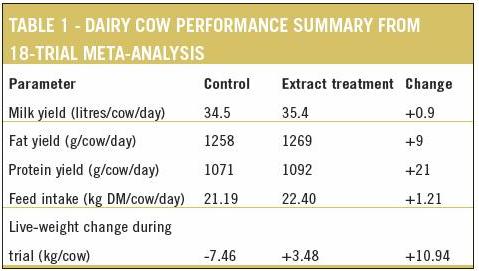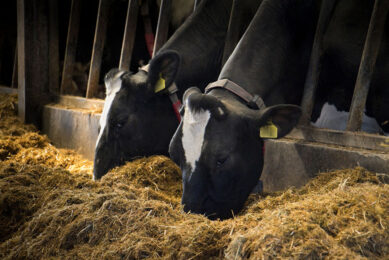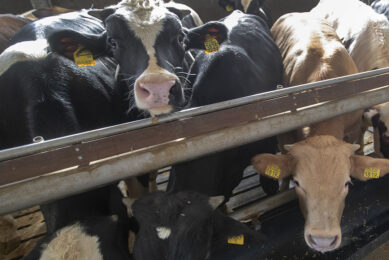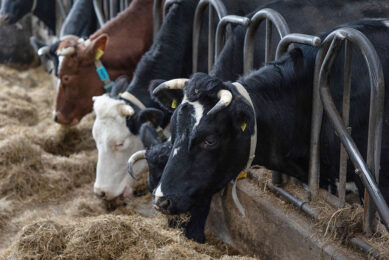Increasing role for plant extracts in cattle diets

The interest in plant extracts as performance enhancers for dairy cows or growing cattle is increasing. That is according to Dr David Bravo from Pancosma who presented two large-scale meta-analyses in ruminants at a meeting held in Rennes, France.
In France, Dr Bravo presented evidence of and an explanation for the growing momentum in extract-based feed supplements. In milk production, 18 trials involving 947 cows on the combination of cinnamaldehyde and eugenol found beneficial responses in yields of milk, butterfat and protein, and in feed intake and live-weight (Table 1).
Hypothetically, the financial gain for farmers from these results could extend beyond additional revenue from higher yields of milk volume and solids, according to Bravo. “At a likely energy density in the diet of 12MJ/kg DM, the increased feed intake would result in 14.5MJ a day of additional energy intake,” he says. “If this was converted entirely into milk, the additional production would be about 2.7 litres per cow per day, or nearly two litres more than was found. But the live-weight changes found in these trials strongly suggest that some of the additional energy is being partitioned towards body reserves. “In high yielding herds, where negative energy balance in early lactation has a detrimental bearing on cow fertility, this could have a marked impact. Also in later lactation, this could allow diet specification and therefore cost to be reduced while maintaining cows’ body condition at the target level for drying off.”
Beef performance
The beef performance meta-analysis involved results from 18 trials and 980 growing cattle on the three-way combination of cinnamaldehyde, eugenol and capsicum. It found higher feed intake and live-weight gain, improved feed conversion efficiency and markedly reduced treatment rates for ill health (Table 2). The two active ingredients involved in both sets of trials, cinnamaldehyde (C9H8O) and eugenol (C10H12O2), are both naturally occurring compounds extracted from plant materials. According to Bravo, their modes of action combine to extract more nutrients from a given amount of feed. He said cinnamaldehyde stimulated the production of propionate, the precursor of blood glucose, thereby reducing the acetate(C2):(C3)propionate ratio resulting from rumen fermentation. It also decreased the loss of nitrogen (as ammonia) in the rumen by inhibiting protein degradation at deamination and peptidolysis. Eugenol, he explained, increased the total energy extracted from the diet in the form of higher volatile fatty acid production (Figures 1 and 2).
The third plant extract in the beef trials is capsicum (C18H27NO3), intended for use primarily in medium to high fermentable carbohydrate beef diets. Its mode of action included modifying the distribution of feed consumption over the course of a day, explained Bravo. “It reduces the size of the first meal after fresh feed is offered and increases consumption at visits to the feed trough later in the day,” he said. “One advantage of this is reduced rumen acidosis resulting from the first big feed of the day.” On the back of such evidence, the commercial use of plant extracts is growing apace, according to Dr Michael Cecava, director of feed technology at ADM’s research division. In US dairy production, he said the financial payback from plant extract supplemented diets in high yielding cows was just over $20/cow/month (Table 3).
In growing cattle, Cecava said extract-supplemented feeds were being used to increase growth rates and improve feed conversion. In addition, his company was using plant extracts in specialist feed applications to combat heat stress in dairy cows, and fescue toxicosis in grazing cattle caused by a widespread fungal infection in US fescue grassland.
Controlled release
Bravo said the active ingredients of Xtract 6965 containing cinnamaldehyde and eugenol for forage based diets (i.e. mainly dairy cows), and Xtract 7065 containing cinnamaldehyde, eugenol and capsicum for medium to high concentrate diets (i.e. intensive beef) are micro-encapsulated with hydrogenated vegetable oil. “This controlled-release formulation creates a much longer dwell-time, and therefore duration of activity, in the rumen compared with liquid presentation,” he said. On the global significance of these developments, he said many countries are now producing significant amounts of milk and meat without antibiotic growth promoters, even where their use was still authorised, in order to satisfy consumer expectations. In this context, he said the pan-European demand for places at the meeting suggested that plant extract-based performance enhancers had a major role to play.
Source: Feed Mix magazine Vol. 17 No. 1 (2009)











